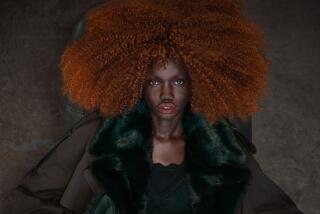Chatting With Top-Drawer Clerks
- Share via
An Irish clerk with a dimple and a brogue came over as I was studying V-neck sweaters at the Blarney Woolen Mill shop in Cambridge.
“And may I help you?” she asked.
“Sure,” I said. “I’m trying to decide on a gift. Either the white cotton sweater with navy trim, or the cream-colored V-neck piped in navy and burgundy.”
“I’d get the cream color,” she said without a pause. “It looks more English, like a cricket sweater. I like to buy something typical of a place when I travel. I mean, if I were in America, I would want to buy something with baseballs on it.”
Sold.
As she rang it up, she added: “I bet you’re from California. I visited California once and I never met anyone boring there.”
I was both charmed and speechless.
One of the joys of shopping on a trip is the chance to chat with such characters.
In the London flagship store of Burberrys (18-22 Haymarket), I was greeted by a white-haired gentleman whose speech was as crisp as his collar. When I asked about their trench coats, he explained that the more contemporary brushed-cotton styles were on the first floor.
Personally, however, he stands by the traditional Burberrys--the classic, double-breasted waterproof garment with epaulets and straps. They were on the lower level. “We don’t like to call it the basement ,” he said. “If I had my way, they would be here on the main floor.”
Burberry invented the trench coat in 1914, by government order. Half a million of them (then called the Burberry Trench-Warm) went off to World War I. The resilient fabric that made them different is a twice-waterproofed cotton gabardine patented by Thomas Burberry in 1888.
My favorite testimonial--which is framed and hangs on the Haymarket wall--is from the Antarctic hero Roald Amundsen, first man to reach the South Pole. “We had overalls of Burberry gabardine for sledge journeys where one has to save weight,” he wrote. “ . . . I must unhesitatingly recommend Burberry.”
Amundsen’s tent for the 1911 polar expedition was also made of Burberry cloth, the clerk told me. And it is still shown in museums.
I admired hundreds of khaki trench coats, lined and unlined, on that unseasonably warm day, but did not make a purchase. You need to mull awhile, I figured, before buying a coat that is indestructible.
Next I nipped around the corner to Piccadilly to wander through the elegant food halls of Fortnum & Mason. A friend, who spent two years in London, had hinted that she missed having Fortnum’s honey with her breakfast, and if I ever had the time. . . .
In the glow of a crystal chandelier, I found a Winnie-the-Pooh-sized pot of chunk comb honey. But was that what she wanted? On the same shelf were jars of lavender honey, heather honey, English flower honey, macadamia blossom honey, Cornish honey, Guatemalan honey, Tasmanian leatherwood honey, Mexican Yucatan honey, Hungarian acacia honey, Hungarian sunflower honey, Canadian clover honey and even Glenlivet honey--laced with single-malt Scotch whisky.
In confusion, I moved on to marmalades. The labels promised “Thick Cut Sir Nigel’s Vintage,” “No Peel,” “Double One” and “Double Two.”
A clerk in morning coat stood nearby. I asked for guidance.
“‘Double Two’ is thicker,” he said. “‘Double One you can pour.”’
I did not like the notion of either honey or marmalade running loose in my luggage.
Instead, I bought an empty cream-colored crock that said simply “Fortnum & Mason.” If my friend does not want it, I do.
The best window shopping in London may be in the Burlington Arcade, a remnant of the early 19th Century that cuts an aristocratic swath between Piccadilly and Cork Street near Savile Row.
Built in 1819, the arcade is rich with bowed-glass fronts, gleaming carriage lamps, hanging flowers and an arched, pale aqua ceiling. Lush cabled cashmeres are artfully arranged at N. Peal’s, at either end of the arcade.
You can have hair brushes re-bristled at Clements (at No. 63), or discover a trove of antique pocket watches, cameos, sterling stickpins and other heirloom jewelry at Demas. At Hummel Toys, the windows are jammed with miniature trunks and doll clothes, teddy bears and whole regiments of toy soldiers.
The Burlington is patrolled by two top-hatted fellows called beadles , who impose 19th-Century rules: no whistling, no singing, no hurrying in the arcade.
When I asked a beadle if he had ever apprehended a whistler, he smiled and tipped his hat.
“It’s been some time,” he admitted. “But one can’t be too careful.”
More to Read
Sign up for The Wild
We’ll help you find the best places to hike, bike and run, as well as the perfect silent spots for meditation and yoga.
You may occasionally receive promotional content from the Los Angeles Times.





